The Nexus 6 Review
by Brandon Chester on November 12, 2014 1:00 PM ESTDisplay
The display is one of the most important aspects of a smartphone, as it is the part of the device that the user will interact with most. We've seen tremendous improvement in smartphone displays as they have become more and more commonplace within society. The first area of improvement was resolution, which made sense with text being a necessary part of essentially every smartphone application. As displays have gotten to the point where there is little benefit to further increasing pixel density, we have also seen a push for greater color accuracy and image rendition. On the Android side of the market, Google was one of the first companies to start taking color accuracy seriously, and the Nexus 7 and Nexus 5 had some of the best calibrated displays of all Android devices.
The Nexus 6 sports a 5.96" AMOLED display with a resolution of 2560x1440. Given Google's work to provide accurate color calibration on the Nexus 5, and the massive improvements that we've seen in the calibration of AMOLED displays over the course the past year, I was very excited to take a look at the display on the Nexus 6. However, as someone who typically uses the very well calibrated iPhone 6 and Nexus 5 in daily use, I immediately noticed that the Nexus 6 produced a punchier image than I was used to seeing in the applications I use frequently.
To take a look at the characteristics of the Nexus 6's display we turn to SpectraCal's CalMAN 5 software and an X-Rite i1 Pro 2 spectrophotometer for accurate measurements of the display's color. As always, we target the sRGB gamut which is currently the standard for photos on the web and video content.
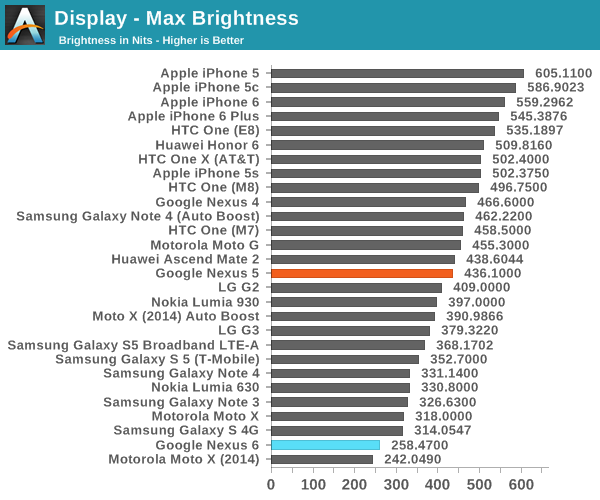
Contrast and black levels on the Nexus 6 are as incredible as ever. Brightness is definitely on the low side though. Testing was performed with both the manual brightness settings, and with Adaptive Brightness enabled and a bright LED aimed at the light sensor. In both cases the maximum brightness was the same, there's no higher brightness exposed when using the automatic brightness settings like there is for the Galaxy Note 4. What's interesting to note is that the brightness is similar to that of the 2014 Moto X, another recently released Motorola device that sports an AMOLED panel. However, even Moto X has an auto boost mode which pushes it up to 390nits. The overall similarity between the panel in the Moto X and the panel in the Nexus 6 persists throughout our other tests.
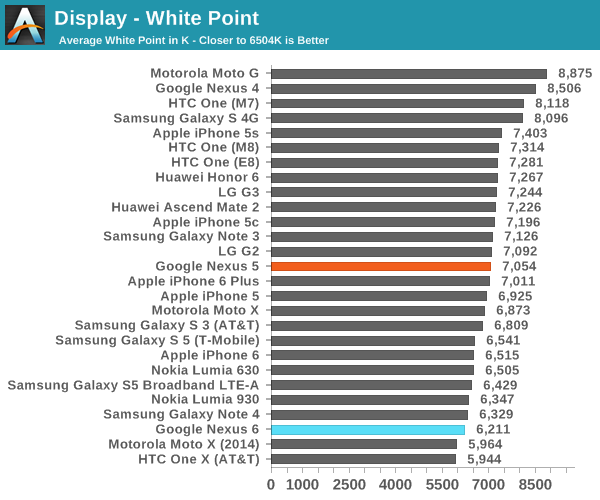
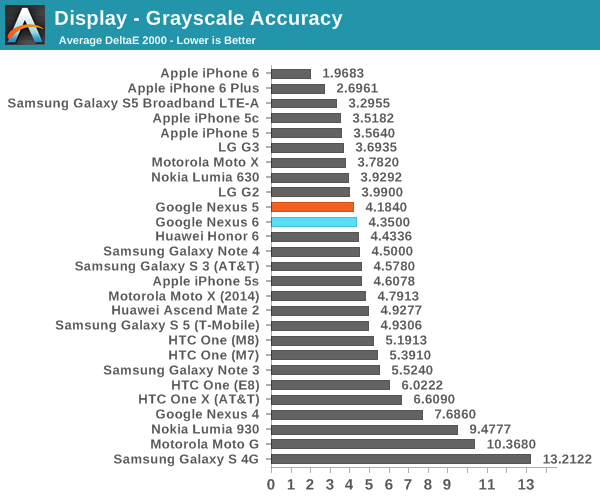
The Nexus 6 is slightly more red than our target for white point, though not to the extent of the 2014 Moto X. This contrasts with the IPS panel in the Nexus 5 which was too blue. In the greyscale we see that the luminance is comprised more of red and green than of blue. This translates to greyscale performance that is nothing exceptional, but not noticably worse than the Nexus 5, and still significantly improved compared to AMOLED panels from not long ago like the display in the Galaxy Note 3.
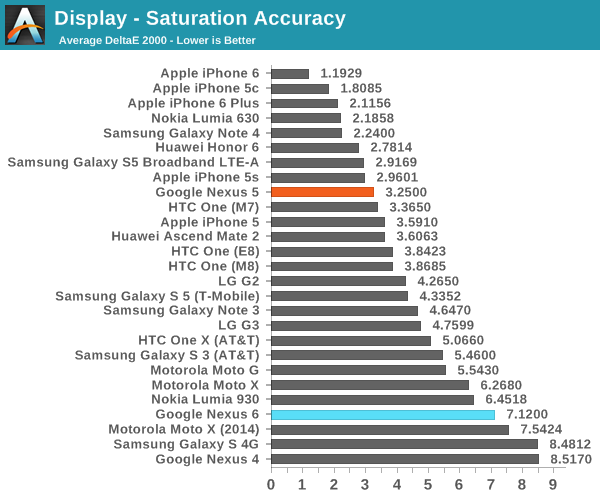
In our saturation sweep test, the Nexus 6 performs rather poorly. Unlike Samsung's phones which have several display modes with one of them targeting sRGB, the Nexus 6 has only one display setting and it significantly overshoots the sRGB gamut. This does a good job at creating showroom appeal but is not helpful in accurately displaying the color in photos and videos. This is especially disappointing because the Nexus 5 was well calibrated to sRGB and performed much better in this test.
The poor performance in the saturation sweep translates to equally poor performance on the ColorChecker test. The expanded gamut and saturation compression makes it effectively impossible for this display to render any sRGB content accurately. The greyscale performance helps to bring down the overall average, but the large errors with color mixtures prevent any sort of accurate image rendition.
I was highly disappointed by these results. Like I said earlier, we've seen great improvements in the quality of AMOLED displays as of late, and Google took color calibration very seriously with the Nexus 5. The Nexus 6 shows significant regression in color accuracy from the Nexus 5, and the maximum brightness is much lower. It should also be noted that despite its higher resolution, its larger size means that compared to the Nexus 5 the pixel density only increases 12% from 441 PPI to 493 PPI. The use of a PenTile RGBG subpixel layout also means that there is actually an overall decrease in subpixel density.
Overall, the Nexus 6 display is quite poor relative to the displays on other smartphones like the Galaxy Note 4, iPhone 6, and HTC One (M7). It's also a definite regression from the display on the Nexus 5, which is concerning given the fact that the Nexus 6 is $300 more expensive. It has been speculated that Motorola is unable to source the latest generation of panels from Samsung Display, which would explain why many of the panel characteristics are similar to previous generation AMOLED panels in the Note 3 and Galaxy S4. Although the efficiency of AMOLED displays when displaying black helps to reduce power usage with features like Ambient Display which wakes up the phone when notifications arrive or it is picked up, I don't believe it's worth the trade-off if it involves such heavy sacrifices in color accuracy and brightness.


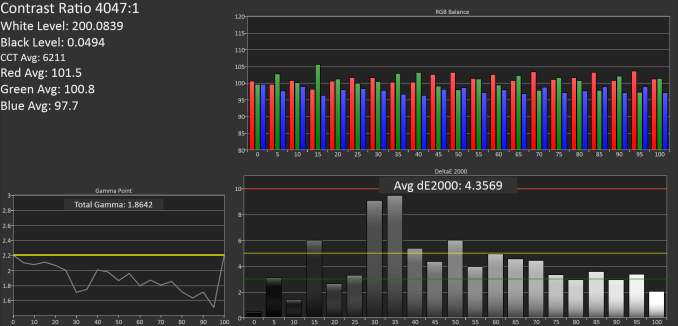
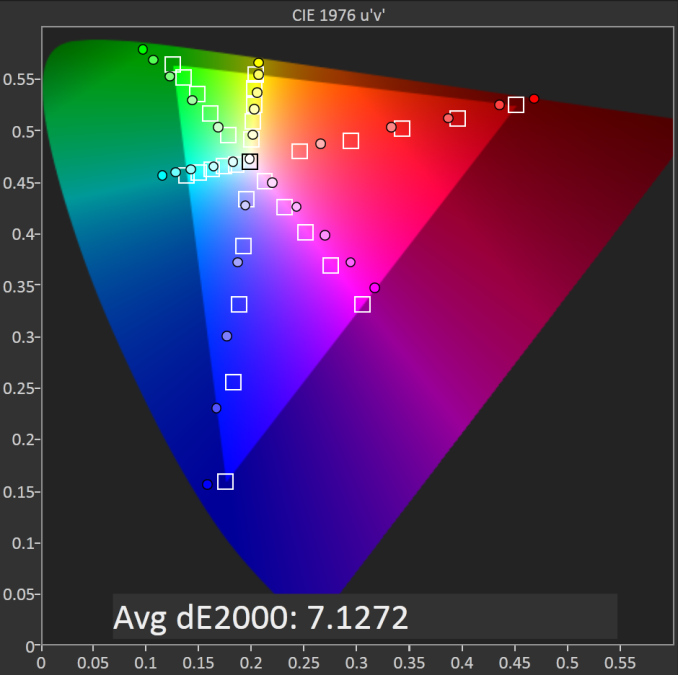









136 Comments
View All Comments
Brett Howse - Friday, November 14, 2014 - link
It's removed and I was "that reviewer".Apparently wifi scores are the single most critical piece of any smartphone review so this won't happen again.
jaysns - Thursday, November 13, 2014 - link
If you do the storage performance tests with the encryption enabled and disabled on the Nexus 5 you see a huge difference. As the 6 comes with this on by default and does not have a way to manually disable this (as far as I know) I'd love to see a follow up article by Anandtech on this issue and see if they can reproduce this and possibly find a way to disable it on the Nexus 6 and compare results. Based on what I've seen, if I can't disable it, or their storage is really just that slow, it would make a difference on my purchasing decision and possibly help other in the same boat. So please do a follow if you can :)Vizsla1986 - Thursday, November 13, 2014 - link
This particular review is an outlier against all the others, which are basically raves. Some of that is explicable - a lot of sites do pro forma reviews colored by a priori bias - but not all.Since I'm someone who purchased the original Moto X (loved it), upgraded to the Droid Turbo a couple of weeks ago (hated it. Returned it immediately) and then bought a 2nd Gen Moto X, a couple of comments based on actual experience.
1) Everyone needs to look at specs with a jaundiced eye. Sometimes they matter (storage) and sometimes it's contextual (RAM, for example. Depends on how system is used) but most of the time it's about throughput.
2) The Moto X was at least as fast, if not faster on throughput then every phone I compared it to, despite worse specs. A lot of that was display. 720 p is a lot easier on a system than 1080, but also not nearly as good. The 2nd gen. Moto X is *faster* in everyway, IMHO, than the Droid Turbo. I'd say that's also display-related, but the difference here is that the Turbo's screen (same as the Nexus 6) wasn't any better to my eyes than the Moto X 1080. YMMV, but one should carefully check this out. If you can't tell the difference (or much of one) consider the system impact.
2) The Moto X is clearly as fast (actually seems faster) as the Turbo despite an 801 chip compatred to the 805, and different clock speeds. Since I haven't had a chance to handle the Nexus 6, I can't compare, but I would urge anyone considering to pick the the two phones and compare throughput.
3) Clearly the Phablet Nexus 6 is a different experience than a smaller phone. I'm struck, though, that every single review I've read (maybe 6 of them now) has screamed themselves hoarse about how good the Nexus screen is. It's ok to be different, but *that* different? I'd recheck my report if I were the only person criticizing what everyone else thought the best thing about the phone. That's not different. That's idiosyncratic. On a phone this big, display quality is a simple thing to judge. There may be subtleties presenting on measurement, but one should be able at a glance to judge good or bad. I find this review suspect on that ground, never mind the measurements. FWIW, the DROID TURBO was bright enough. So is the Moto X. Why should the Nexus 6 be so different?
4) The price seems eminently reasonable, considering dimensions and specs. I understand why people want to see a cheaper Nexus alternative, but pricing needs to compared against delivered value, not just what one wished for.
5) Battery life. FWIW, I have never, ever, ever never needed to recharge any of the three Motorola phones I've had recently (Moto X Nos. 1 & 2 and the Droid Turbo)before going to bed. Once in a while I've drained to to a 10% remaining, but that would be it. The Turbo had an immense batterry (3900), so that's one explnation, but the 2nd Gen Motox X has only 2400 (from memory. Might be 2200). No problem. Motorola engineers are good at designing systems that get through the day on a charge. The Nexus has what? 3200? That ought to be good enough.
To be fair, everything depends on usage, and I'm not the hardest guy on batteries out there. I watch very little media (so no display drain), mostly calls, text and browsing. Someone else might have a much worse time of it. All I can attest to is my Moto phones have been spectacularly good (for me, anyway).
When I make a major purchase, I always check various vendors and compare thoroughly. If this review were in a purchase matrix I was running, I'd throw it out. It's always been a good policy for me to disregard the high and low bidders (or reviews) unless there was an exceptional circumstance. I don't see one here. I don't trust this review. I can't remember ever saying that about any other AnandTech report.
Graag - Sunday, November 16, 2014 - link
>This particular review is an outlier against all the others, which are basically raves. Some of that is explicable - a lot of sites do pro forma reviews colored by a priori bias - but not all.This is not true at all. Both the arstechnica and Verge reviews also found the Nexus 6 to be "meh".
randomlinh - Friday, November 28, 2014 - link
I dunno, most of the reviews seemed like a mixed bag to me, though leaning positive. But on the screen... AT is one of the only site to give tested numbers. Everyone has been a subjective "it looks great, just a little dim, but probably bright enough". That's not entirely helpful.The Note 4 gets a huge nod from displaymate which seems to mirror the results here: http://www.displaymate.com/Color_Accuracy_ShootOut...
gg555 - Thursday, November 13, 2014 - link
Sigh. No review of the noise cancellation. No mention of whether or not it has the four microphone noise cancellation found in the Moto X. No mention of whether it uses Motorola's CrystalTalk, Qualcomm's Fluence, Audience, or some other noise cancellation.My favorite part of the AnandTech cell phone reviews has totally died. And they were the only one doing it. What a shame.
davidc1 - Saturday, November 15, 2014 - link
Yes, yes, yes! Why no mention of audio quality, call quality, noise cancellation, etc, etc. Very disappointed.lanwellon - Thursday, November 13, 2014 - link
Hi, Brandon, I think you should point out that the reason why the Nexus 6 use the battery so quick is not all because of the bigger screen and more powerful CPU, please be noticed that in all the mobile phones you tested in this table, Nexus 6 is the only one running Android L, and Google enabled FDE (Full-Disk Encryption) function by default from Android 5.0. From my experience using Android 4.0 (Ice Cream Sandwich) FDE function, this can be a reason that cause the battery running down very fast. iPhone also enable FDE function by default, but it seems that Apple optimized it pretty well, so the impact to the battery usage is not that big.ol1bit - Friday, November 14, 2014 - link
There is always a segment of the population that buys Nexus devices because they are factory boxes. This is too make sure people who want a Samsung, HTC, etc. phone are not swayed by the low price to a Nexus device. Goggle doesn't want manufactures to die off, the price of a phone is not how they make their money.murphsp1 - Friday, November 14, 2014 - link
I have owned several Nexus devices and must say that the battery life numbers on this one look terribly disappointing ... and will only get worse over time. I just hope that more manufacturers start to understand that many would happily trade off an extra mm or two in thickness for an extra day of battery life. Now, fingers crossed that the Google Play edition of the Droid Turbo is coming ...